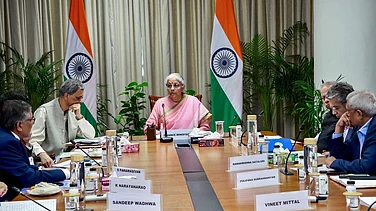With the Reserve Bank of India (RBI) recently lowering risk weights for bank finance to non baking finance companies (NBFCs and microfinance loans), the sector heaved a sigh of relief with the assurance to unlock more funds and boost credit.
Both NBFCs and microfinance institutions have witnessed a slow down in their lending after the central bank tightened lending norms by raising the risk weight in November 2023.
At a time, when the NBFC sector are just coming out of their struggle, in an exclusive interview with Outlook Business, Arul Selvan D, President and CFO of Cholamandalam Investment and Finance talks about how the NBFCs can address the challenges without violating any RBI guidelines.
The RBI's recent rate cut after five years may have mixed effects on the NBFC sector, with experts noting banks' liquidity concerns. What do you think will be the impact of the rate cut on the NBFC sector?
It all depends on how your borrowings are benchmarked against. You can have borrowings that are directly linked to the repo price, or it can be linked to MCLR. Let's say, broadly floating rate, fixed rate is anyway not a concern. So, in the case of repo linked, the benefit is immediate. In the case of T-bills also, it will more or less be immediate because the rate reduction, most of the T-bill reductions happened even before the repo rate cut because that expectation was getting built into the pricing of T-bills. But bank MCLR may take a little time to reduce because bank MCLR need not necessarily change immediately after the repo link, but possibly it will change. So, these three things, if we go over, let's say, two to three months depending on how the banks absorb the MCLR, repo rate cut in their MCLR, there will be some improvements in the pricing.
The RBI has been encouraging NBFCs to diversify their funding sources in order to reduce risk. How do you intend to broaden your company's funding sources to align with RBI guidelines?
There are many ways you can do that. For example, we have done securitization instead of bank borrowing. So, that is when ECBs, then public debt and market borrowings, which is like information funds or insurance companies are happening from their funds. Of course, you can also go overseas to the bond markets abroad. Over some period, we may look at doing it also in the future. But typically, these are the avenues available for, let's say, an Indian NBFC to seek funds from. These are the typical ways of diversifying the debt sources. Equity, of course, is different. Equity can happen from the domestic market or international market. But I think we are talking more on the debt side.
You previously mentioned that the company has not faced any equity issues. What major initiatives or steps have you taken to maintain liquidity during a time when many other NBFCs are facing difficulties in this area?
It is primarily the confidence of the banks that are lending or the market lenders to be willing to put money with you. So, your group standing and your standing in the industry helps. Your corporate governance and your credibility always matter when it comes to getting enough sources of liquidity. So, for example, even when banks are rationalizing their NBFC lending, they are rationalizing in a way that they are moving away from a little bit of an unknown NBFC or a recently evolved NBFC to much more credible, stable, larger, promoter-based, or better corporate governance-oriented promoter-based companies like any of the large NBFCs which are currently available today. So, that shift is happening, and that is where there has been no dearth of funding for us.
And the other aspect is we also generate a lot of priority sector assets where banks have an appetite for priority sector assets. So, that helps us to get better rates as well as continued funding from banks, which is mostly the case with other vehicle finance companies also.
With the recent income tax cuts announced in the budget, do you expect the lending to come down, with more money left in the hands of the masses?
I think, the tax rate reduction is symbolic. It is not the one which is going to drive consumption. Consumption is driven by better earning by the ultimate public. That will come with more capex, more revenue generating activities at the ground level.
So, if you look at it for the past few quarters, lot of elections are happening, there were lot of changes in the government. So, lot of actions to spend government spending has been slowed down. Now, when the government spending happens, money will come into the hands of the consumers who will then spend on purchasing white goods, purchasing consumptive material like that which would then spur growth.
But it's a government way of saying, yes, you want to help the ultimate taxpayer by reducing the burden a little bit. But that by itself is not going to change the requirement for funding or it is not going to largely change consumption.



























